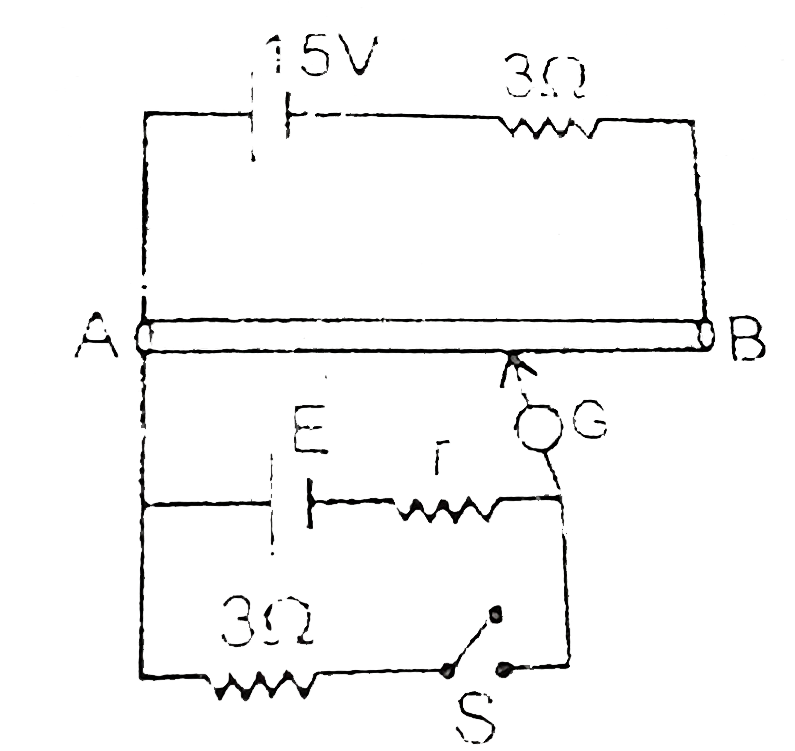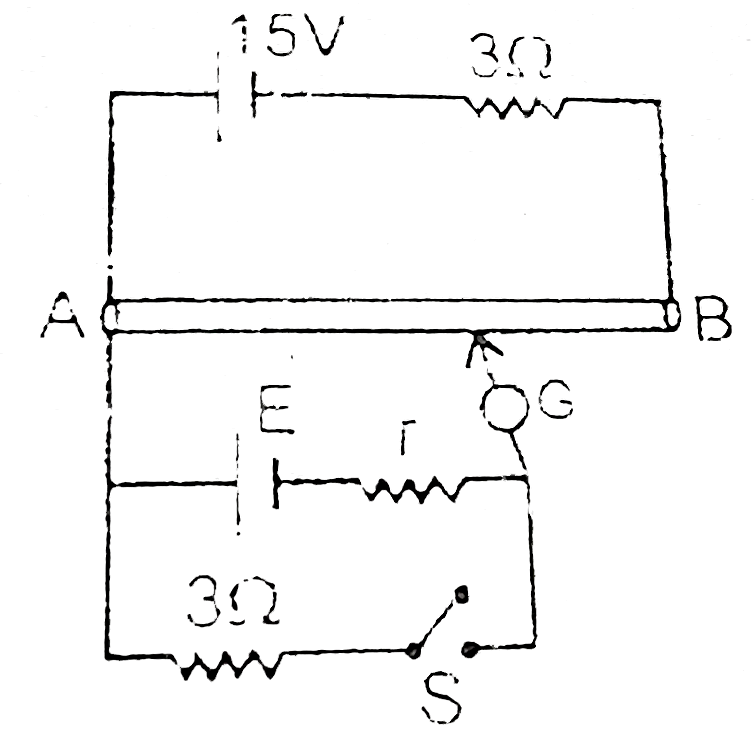Assertion : In potentiometer experiment, null point cannot be obtained if emf of unknown battery is more than the emf of known battery.
Reason : By increasing the emf of known battery, null point length increases.
A. If both Assertion and Reason are true and Reason is the correct explanation of Assertion.
B. If both Assertion and Reason are true and Reason is not correct explanation of Assertion.
C.If Assertion is true but Reason is false.
D. If Assertion is false but Reason is true.
The correct Answer is:C
To solve the given question, we need to analyze both the assertion and the reason provided.
1. Understand the Assertion:
- The assertion states that in a potentiometer experiment, a null point cannot be obtained if the EMF of the unknown battery (E1) is greater than the EMF of the known battery (E).
- This is based on the principle of the potentiometer, which states that the potential difference across a length of wire is proportional to the length of the wire. If E1 > E, there will not be enough potential difference in the potentiometer to balance the unknown EMF, hence no null point can be found.
2. Understand the Reason:
- The reason states that by increasing the EMF of the known battery, the null point length increases.
- This is misleading. While increasing the EMF of the known battery does increase the potential gradient, it does not necessarily mean that the null point length will increase. Instead, if the known battery's EMF is increased, the length at which the null point is found may actually decrease because the potential difference across the potentiometer wire becomes larger.
3. Analyze the Relationship:
- The potentiometer works on the principle that the potential gradient (V/L) is constant. If the EMF of the known battery is increased, the potential difference across the potentiometer wire increases, which can lead to a shorter length being required to balance the unknown EMF.
- Therefore, the assertion is correct, but the reason is incorrect.
4. Conclusion:
- Based on the analysis, we conclude that the assertion is true while the reason is false.
Final Answer:
The assertion is true, but the reason is false.
- The assertion states that in a potentiometer experiment, a null point cannot be obtained if the EMF of the unknown battery (E1) is greater than the EMF of the known battery (E).
- This is based on the principle of the potentiometer, which states that the potential difference across a length of wire is proportional to the length of the wire. If E1 > E, there will not be enough potential difference in the potentiometer to balance the unknown EMF, hence no null point can be found.
- The reason states that by increasing the EMF of the known battery, the null point length increases.
- This is misleading. While increasing the EMF of the known battery does increase the potential gradient, it does not necessarily mean that the null point length will increase. Instead, if the known battery's EMF is increased, the length at which the null point is found may actually decrease because the potential difference across the potentiometer wire becomes larger.
- The potentiometer works on the principle that the potential gradient (V/L) is constant. If the EMF of the known battery is increased, the potential difference across the potentiometer wire increases, which can lead to a shorter length being required to balance the unknown EMF.
- Therefore, the assertion is correct, but the reason is incorrect.
- Based on the analysis, we conclude that the assertion is true while the reason is false.
The assertion is true, but the reason is false.
Topper's Solved these Questions
- CURRENT ELECTRICITYBOOK - DC PANDEY ENGLISHCHAPTER - CURRENT ELECTRICITYEXERCISE - Match the columns
4 Videos
- CURRENT ELECTRICITYBOOK - DC PANDEY ENGLISHCHAPTER - CURRENT ELECTRICITYEXERCISE - Medical entrances gallery
97 Videos
- CURRENT ELECTRICITYBOOK - DC PANDEY ENGLISHCHAPTER - CURRENT ELECTRICITYEXERCISE - Taking it together
142 Videos
- COMMUNICATION SYSTEMBOOK - DC PANDEY ENGLISHCHAPTER - COMMUNICATION SYSTEMEXERCISE - Subjective
11 Videos
- ELECTROMAGNETIC INDUCTIONBOOK - DC PANDEY ENGLISHCHAPTER - ELECTROMAGNETIC INDUCTIONEXERCISE - Medical entrances gallery
25 Videos
Similar Questions
Assertion : In case of potentiometer experiment, if emfs of known and unknown both batteries are increased two times, then null point length will remain unchanged.
Reason : Null point length does not depend on emf of either of the two batteries.
View SolutionAssertion : Potential difference across the terminals of a battery is always less than the emf of the battery.
Reason : During discharging of a battery potential differnce across to terminals of a battery is
V=E−ir
∴V<E
View SolutionCan the potential difference across a battery be greater than its emf?
View SolutionIn potentiometer experiment, null point isobtained at a particular point for a cell on potentiometer wire x cm long. If the lengthof the potentiometer wire is increasedwithout changing the cell, the balancing length will (Driving source is not changed)
View SolutionAssertion : The e.m.f. of the drivercell in the potentiometer experiment should be greater than the e.m.f. of the cell to determined. reason ; the fall of potential across the potentiometer wire should not be less than the emf of the cell to be determined.
View SolutionA wire AB (of length 1m, area of cross section πm2) is used in potentiometer experiment to calculate emf and internal resistance (r) of battery.
The emf and internal resistance of driving battery are 15 V and 3Ω respectively.The resistivity of wire AB varies as ρ=ρ0x (where x is distance form A in meters and ρ0=24πΩ)

The distance of null point from A obtained at √23m when switch 'S' is open and at 1√2m m when switch is closed.
The emf (E) of battery is -
View SolutionStatement-1 : In a Meter Bridge experiment, null point for an unknown resistance is measured. Now, the unknown resistance is put inside an enclosure maintained at a higher temperature. The null point can be obtained at the same point as before by decreasing the value of the standard resistance.
Statement-2 : Resistance of metal increases with increase in temperature.
View SolutionStatement-1 : In a Meter Bridge experiment, null point for an unknown resistance is measured. Now, the unknown resistance is put inside an enclosure maintained at a higher temperature. The null point can be obtained at the same point as before by decreasing the value of the standard resistance.
Statement-2 : Resistance of metal increases with increase in temperature.
View SolutionA wire AB (of length 1m, area of cross section πm2) is used in potentiometer experiment to calculate emf and internal resistance (r) of battery.
The emf and internal resistance of driving battery are 15 V and 3Ω respectively.The resistivity of wire AB varies as ρ=ρ0x (where x is distance form A in meters and ρ0=24πΩ)

The distance of null point from A obtained at √23m when switch 'S' is open and at 1√2m m when switch is closed.
Internal resistance of battery E is -
View SolutionA wire AB (of length 1m, area of cross section πm2) is used in potentiometer experiment to calculate emf and internal resistance (r) of battery.
The emf and internal resistance of driving battery are 15 V and 3Ω respectively.The resistivity of wire AB varies as ρ=ρ0x (where x is distance form A in meters and ρ0=24πΩ)

The distance of null point from A obtained at √23m when switch 'S' is open and at 1√2m m when switch is closed.
The current through 15 V battery (with IG=0)
View Solution
